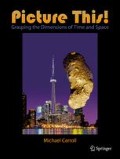Abstract
To understand the overall scale and distances of our planetary system and all its inhabitants, including the planets, asteroids and comets, we must first get a little background. The early solar nebula, the great cloud of dust and gas from which all planets and moons and other objects came, originally lacked any big planets. The Solar System began as a great cloud of interstellar gas, much like many of the beautiful nebulae we see today (see Chap. 6). Those nebulae provided clues to early theorists about how our Solar System came together. Among them, Swedish scientist Emmanuel Swedenborg proposed a simple “nebular hypothesis” in 1734. His theory described a hot globe of material around the infant Sun as the birthplace of the Solar System. German philosopher Immanuel Kant (1755) later enhanced his theories. French astronomer Pierre-Simon Laplace (1796) added even more detail, suggesting that the primordial cloud surrounding the Sun somehow flattened into a disk, eventually leading to the genesis of the planetary system.
Access this chapter
Tax calculation will be finalised at checkout
Purchases are for personal use only
Notes
- 1.
Sadly, Halley did not live to see the confirmation of his prediction. He died 16 years before the comet’s return.
- 2.
All asteroid names are preceded by a number indicating the order in which they were found. 1 Ceres was the first asteroid discovered, while 4 Vesta was fourth to be found.
- 3.
While the Titius-Bode law accurately predicted the location of Uranus, it did not explain the lack of a planet between Mars and Jupiter, nor did it predict the location of Neptune, which does not fit its pattern. Today, the Titius-Bode law is generally considered little more than a numerical oddity.
- 4.
As of September 20, 2014. This includes 101 confirmed and 83 probable. See William Robert Johnson’s summary at http://www.johnstonsarchive.net/astro/asteroidmoons.html#2.
- 5.
With an uncertainty of ±6 km.
- 6.
Some, like Ceres, also have a large component of ice.
- 7.
Astrophysical Journal, 328: L69–L73, 1988 May 15.
- 8.
Sedna is actually so far out that it may be an inner member of the Oort Cloud.
- 9.
In the case of bodies as small as a comet nucleus, orbit is a loose term. While Rosetta is held precariously within the weak gravity of P67, it travels in a series of triangles, firing its engines three times for every circuit around the comet to remain close.
- 10.
Deuterium is an isotope of hydrogen that weighs twice as much. It is used to calculate how much ancient water a planetary body had during its development.
- 11.
For detailed articles, see the January 23, 2015, issue of Science.
- 12.
Estimates range from 10 to 15 megatons.
- 13.
The Meteor Crater impact has been dated with several independent techniques, including thermoluminescence, cosmogenic 36Cl techniques and exposure ages based on in situ production of 10Be and 26Al. These independent studies all indicate an event at 50,000 years ago, ± 2350 years (average).
- 14.
Due to the meteor’s trajectory, researchers estimate that the event occurred in the early morning or late evening.
- 15.
Estimates have ranged from 5000 to over 500,000 m. t. The figure given is from David Kring’s recent calculations, printed in LPI’s Guidebook to the Geology of Barringer Meteorite Crater.
- 16.
“Air blast produced by the Meteor Crater impact event and a reconstruction of the affected environment,” by David A. Kring, Meteorics and Planetary Science 32, 1997.
- 17.
Some research points to modern birds as being surviving dinosaurs.
- 18.
The Moon, our neighboring world, by Otto Binder. ©1959 by Golden Press, Inc.
- 19.
See Science News online, November 1, 2014.
- 20.
Named after the pioneering impact geologist Eugene Shoemaker.
- 21.
See “The Internal Structure of Asteroid (25143) Itokawa as revealed by detection of YORP spinup,” Lowry, et al., Astronomy and Astrophysics, Volume 562, A48.
Author information
Authors and Affiliations
Rights and permissions
Copyright information
© 2016 Springer International Publishing Switzerland
About this chapter
Cite this chapter
Carroll, M. (2016). Asteroids, Comets and Our Cosmic Landscape. In: Picture This!. Springer, Cham. https://doi.org/10.1007/978-3-319-24907-0_1
Download citation
DOI: https://doi.org/10.1007/978-3-319-24907-0_1
Published:
Publisher Name: Springer, Cham
Print ISBN: 978-3-319-24905-6
Online ISBN: 978-3-319-24907-0
eBook Packages: Physics and AstronomyPhysics and Astronomy (R0)

